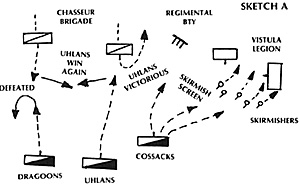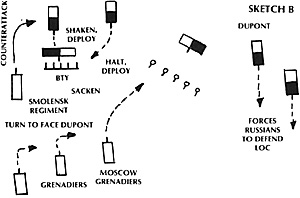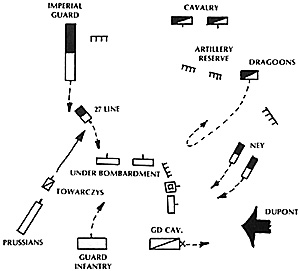
10 A.M. to Noon
The French plan called for Lannes to keep the Russian left in play while Ney and Dupont turned the Russian right. The Russian plan called for a general push all along the front with the Guards and Grenadiers to reinforce any success. The rival opening dispositions are shown on Map 1.
Initial maneuvers were conducted using the dialogue technique. This method has been extensively discussed in past issues of The Courier. Simply explained, it involves each player verbally describing his units' actions and then physically moving the figures to new positions. When a player makes an action that interferes with the opponent's movement, the combat is resolved using the tactical gaming rules, adjustments are made to update all units, and thedialogue continued until a new conflict occurs.
At the Battle of Deppen the first dialogue covered an hour of game time. During this period both sides advanced and selectively deployed. During this dialogue period the French moved 5 inches for every 3 inches moved by the Russians. This reflected our perceptions of the superior French maneuverability, partially a function of training, but mostly a consequence of their superior small unit leadership. The first conflict occurred when the Russian 2nd Cavalry Brigade cantered forward to try to disrupt Ney's approach march.
The Russian Cavalry General Uvarov personally led the 2nd Brigade (The Russian Army had one cavalry general; theFrenchtwo; thisalso reflected theFrench leadership superiority. Each brigade had a generalwho makes detailed tactical decisions regarding formation, etc. However, the presence of a higher level general is necessary to make major tactical changes. This system takes some tactical control away from the players who,afterall, representarmy leaders who shouldn't be overly concerned with tactics. However, it retains some tactical decision making for the player since we enjoy occasionally trying our hand at small unit tactics.) His cossack regiment led the attack in skirmish order followed by the dragoons and lancers in column (see Sketch A).
Seeing the Russian advance, the Vistula Legion formed hasty square (requiring a die roll modifying the unit's base morale since this is a reaction move). They passed and the cossacks closed on the skirmishers. Ideally the skirmishers wanted to fire and run to the square's shelter. To do so they had to assess the number of critical threats they faced (three; one for enemy to front, two for being charged by cavalry while not in square). The skirmishers were rated a veteran unit and thus had a threshold of three (i.e., can face two critical threats without testing morale but must test when facing three, if they face more than three they have an adverse modifier to their roll). The skirmishers failed and retired to the square without f iring. The cossacks reined in outside of musket range and were able to successfully screen the Polish skirmishers and their regimental battery for the duration of the cavalry combat.
Russian Cossacks
A note is in order here about Russian cossacks. Many gamers wonder how to simulate the presence of the large numbers of cossacks who usually were present on the battlefield. We feel that only a portion of this total rendered useful performances on historical battlefields. Accordingly we place on the tabletop only a fraction of the total number present at the battle. Most cossacks are then rated as militia, having to test morale when facing one critical threat.
 Returning to the charge, the French Chasseur Brigade countercharged and a pell mell melee ensued. The French stood, which discouraged Uvarov who had hoped his column formation would overawe the French cavalry (column attacks pose an additional critical threat). The Russian Dragoons were defeated while the Uhlans barely won out. The second phase of the melee saw the two victorious formations turn to fight each other. Uvarov himself drew his sabre to lead this charge. His intervention proved decisive (adding one to the melee die roll) as the Litovski Uhlans scattered the Chasseurs.
Returning to the charge, the French Chasseur Brigade countercharged and a pell mell melee ensued. The French stood, which discouraged Uvarov who had hoped his column formation would overawe the French cavalry (column attacks pose an additional critical threat). The Russian Dragoons were defeated while the Uhlans barely won out. The second phase of the melee saw the two victorious formations turn to fight each other. Uvarov himself drew his sabre to lead this charge. His intervention proved decisive (adding one to the melee die roll) as the Litovski Uhlans scattered the Chasseurs.
Now Uvarov made a fateful decision. Since the 2nd Brigade needed time to regroup he galloped back to the Russian rear to summon reinforcements (in other words this writer made the decision to have Uvarov personally summon reserves rather than relying upon the time consuming, unreliable Russian staff system to transmit an order to the reserves. Having only one cavalry general hurt at this juncture). Leaderless, the 2nd Brigade held its position. The unforeseen consequence of this decision was that the Russian 2nd Brigade effectively shielded Ney's men from Russian artillery fire. At the time I thought the brigade was doing a superb job in jamming up the French advance. Little did I know that Ney had orders to wait until Dupont achieved a flank position before resuming his advance.
The cavalry combat consumed 10 minutes. A brief lull ensued, handled by dialogue; positions were updated and we found we had two more combats on our hands. On the far left, Ostermarm attacked the church (melee calculation: in close combat against buildings only a very limited frontage can engage; basic strength point for the attack is one, defender matches this front with basic strength of one, defender receives two bonus for building, both sides roll). The French repulsed the first two assaults but were worn down so that the third assault carried the position. The French retired to the manor house and Ostermann proved content to hold his position.
 On the left side of the town Samoff faced greater difficulty. His advancing columns faced swarms of French skirmishers (historically at this period the French still had the ability to have line units break out into skirmish order) who only grudgingly withdrew from covered position to covered position. Outside of town the jagers marched in column up the road and were hafted by intense French artillery fire from Verclier's divisional artillery. Samoff did not have the command ability to both control the assault in the town and direct the jagers. Consequently the hapless jagers died in place.
On the left side of the town Samoff faced greater difficulty. His advancing columns faced swarms of French skirmishers (historically at this period the French still had the ability to have line units break out into skirmish order) who only grudgingly withdrew from covered position to covered position. Outside of town the jagers marched in column up the road and were hafted by intense French artillery fire from Verclier's divisional artillery. Samoff did not have the command ability to both control the assault in the town and direct the jagers. Consequently the hapless jagers died in place.
Ground down by skirmish fire, Samoff's assaults lacked vigor. Although his orders called for him to seize this section of the town, I made the game decision to try to call off the attack. This relied upon Samoff meeting his command rating. Although a mediocre general at best, Samoff passed his roll and went onto the defensive.
And so noon came. On the Russian left the attack had bogged down. In the center one of Samoff's brigades lay in defensive positions having suffered 40%, losses while the other brigade over the river was just coming to grips. The 2nd Cavalry Brigade lay well out to the front seemingly keeping Ney in check while Uvarov at last was bringing up some reinforcements to resume the attack. On the right Dupont was about to attack. Up to this point neither player had sent any orders to adjust his game length plan. Napoleon, pleased with his progress, catnapped on the ridge behind Dupont's men. Bennigsen supervised the completion of a pontoon bridge north of town and received word that Prussian reinforcements were approaching.
 Noon to 2:30
Noon to 2:30
Shortly after noon, Samoff's second brigade ascended the heights on which an old castle ruin lay. Sheltered behind earth and stone walls, the French defenders poured a hot fire. Undaunted, the Russians attacked repeatedly. Just as the defenders began to be worn down, Oudinot intervened (as when Samoff called off his attack, the player tries to make an optimal tactical move and to do so has to pass a die roll based on Oudinot's ability). Oudinot's attack hit the flank of the Russian regiment and drove the survivors back to the south edge of town. There the Russians rallied and took shelter in a large building. Soon Oudinot's Tirrailleurs de Fro surrounded this position launching repeated attacks against the doors and windows.
 At 12:30 the Prussians arrived near the Russian pontoon bridge site. Bennigsen ordered them to support Samoff's weary warriors. More importantly, Dupont began his assault on the Russian right. Originally Dupont's advance had been slowed by the gallant resistance of a Russian jager regiment along the wooded ridge on the eastern portion of the battefield. Eventually overwhelming numbers of French skirmishers bested the jagers by turning both flanks while maintaining constant frontal pressure. Dupont's soldiers quickly formed column and marched forward. Nearing the southern edge of the field, Dupont dispatched one brigade to threaten the Russian line of communications (by the game's rules, as previously mentioned, this forced a die roll that randomly recalled a Russian unit to protect the LOC). Dupont's demonstration forced the Russian 3rd Brigade (the one being led up by Uvarov!) off the battlefield. Then Dupont turned his attention on Sacken's Division.
At 12:30 the Prussians arrived near the Russian pontoon bridge site. Bennigsen ordered them to support Samoff's weary warriors. More importantly, Dupont began his assault on the Russian right. Originally Dupont's advance had been slowed by the gallant resistance of a Russian jager regiment along the wooded ridge on the eastern portion of the battefield. Eventually overwhelming numbers of French skirmishers bested the jagers by turning both flanks while maintaining constant frontal pressure. Dupont's soldiers quickly formed column and marched forward. Nearing the southern edge of the field, Dupont dispatched one brigade to threaten the Russian line of communications (by the game's rules, as previously mentioned, this forced a die roll that randomly recalled a Russian unit to protect the LOC). Dupont's demonstration forced the Russian 3rd Brigade (the one being led up by Uvarov!) off the battlefield. Then Dupont turned his attention on Sacken's Division.
The capable Sacken placed his men on a low rise with his battery centering the defense with columns of infantry in support. Against this position came three French regiments. The right flank Russian regiment broke under the strain (four critical threats: enemy to front, to flank, column attack, and skirmish superiority). However, two French regiments directed at the battery ran into terrible canister fire from the well served Russian guns.
This intense fire forced the attack columns to halt and deploy. immediately the Smolensk Regiment, held in close support for just this purpose, counterattacked. The French broke in rout. Now came one of the battle's dramatic turning points. Sacken rode back to the Grenadier Brigade stationed several hundred yards behind his front line. He pleaded with the brigade's general to move forward to strike the French while they were disorganized and thus clear the right flank just as the Smolensk had cleared the left.
Recall that the Grenadiers had been ordered to remain in reserve until summoned to exploit a major success. Sacken's limited tactical success did not qualify. Accordingly a die was rolled to test Sacken's leadership ability; if he passed he could control the reserve. The roll was adversely modified since the grenadiers were not under his direct command but were part of Galtizen's Division. Sacken failed and the moment was lost. Although the grenadiers would advance later, it was too late for the French had reformed.
At 1 P.M. Napoleon committed his reserve. Simultaneously Ney resumed his advance. Into the breach went the Prussians. The Towarczys (a cavalry regiment recruited in the Polish part of Prussia) led the Prussian advance. Seeing that the French had not yet deployed, the Prussian General Lestocq ordered them to charge (Sketch C). Hastily the leading French regiment tried to form square. They failed and were overrun by the Prussian Cavalry. While this success slowed the French advance, on the Russian right the flank was slowly crumbling.
Advancing on the heels of the Russian 2nd Cavalry Brigade, which had been finally withdrawn from their exposed position but continued to mask the Russian guns during their retreat, Ney pressed his attack. He planned to use his massed guns to pavethe wayto victory. To allow them to advance and deploy he required the French cavalry to sacrifice themselves upon the Russian guns (Sketch C). Consequently the French Dragoon Brigade charged the Russian batteries. Blown back by point blank canister this attack nevertheless served its purpose. Soon French artillery were pouring canister into the Russian line. The Russian Imperial Guard had to march forward to replace the fallen line troops.
On the far right Dupont attacked the Russian grenadiers. His aggressive skirmish tactics were about to prevail when the Russian Guard Cavalry Brigade forced his soldiers to form square. But it proved a temporary relief. Napoleon sent an order to Dupont to send another brigade to threaten the Russian LOC. This forced another Russian unit to march off to protect the rear. The random roll was made and... exit the Prussians!
Now a gaping hole appeared in the Russian middle. Bearing down directly on it with measured step came the French Imperial Guard. Fortunatelyfor the Russians the heavens opened upand another thunder shower began. This storm lasted the remainder of the day allowing the battered Russians to withdraw.
Surprisingly, actual battlefield losses favored the Russians. They lost 7,200 casualties compared to the French total of 8,800. However, the Russians were forced to abandon their wounded on the battlefield while the French could recover theirs. In addition the uncommitted French cavalry totaling three brigades faced only two uncommitted Russian brigades. This superiority allowed the French to make a campaign die roll on the pursuit table that caused further Russian losses. A French victory, but not on the scale Napoleon had hoped.
The entire action consumed slightly less than four hours of gaming time. We are still feeling our way with the dialogue approach. However, there is no doubt itspeeded up play without sacrificing realism. A key to using this approach is having either a judge, or in our case friendly players who are not out to 'play the rules'.
More Campaign in Poland
Back to Table of Contents -- Courier Vol. VII #2
To Courier List of Issues
To MagWeb Master Magazine List
© Copyright 1986 by The Courier Publishing Company.
This article appears in MagWeb (Magazine Web) on the Internet World Wide Web.
Other military history articles and gaming articles are available at http://www.magweb.com